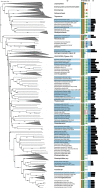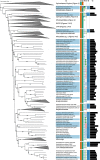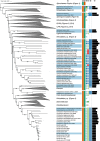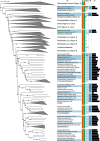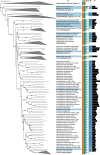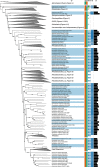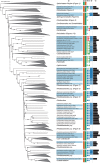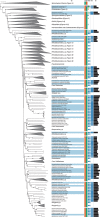Analysis of 1,000+ Type-Strain Genomes Substantially Improves Taxonomic Classification of Alphaproteobacteria - PubMed (original) (raw)
Analysis of 1,000+ Type-Strain Genomes Substantially Improves Taxonomic Classification of _Alphaproteobacteria
Anton Hördt et al. Front Microbiol. 2020.
Abstract
The class Alphaproteobacteria is comprised of a diverse assemblage of Gram-negative bacteria that includes organisms of varying morphologies, physiologies and habitat preferences many of which are of clinical and ecological importance. Alphaproteobacteria classification has proved to be difficult, not least when taxonomic decisions rested heavily on a limited number of phenotypic features and interpretation of poorly resolved 16S rRNA gene trees. Despite progress in recent years regarding the classification of bacteria assigned to the class, there remains a need to further clarify taxonomic relationships. Here, draft genome sequences of a collection of genomes of more than 1000 Alphaproteobacteria and outgroup type strains were used to infer phylogenetic trees from genome-scale data using the principles drawn from phylogenetic systematics. The majority of taxa were found to be monophyletic but several orders, families and genera, including taxa recognized as problematic long ago but also quite recent taxa, as well as a few species were shown to be in need of revision. According proposals are made for the recognition of new orders, families and genera, as well as the transfer of a variety of species to other genera and of a variety of genera to other families. In addition, emended descriptions are given for many species mainly involving information on DNA G+C content and (approximate) genome size, both of which are confirmed as valuable taxonomic markers. Similarly, analysis of the gene content was shown to provide valuable taxonomic insights in the class. Significant incongruities between 16S rRNA gene and whole genome trees were not found in the class. The incongruities that became obvious when comparing the results of the present study with existing classifications appeared to be caused mainly by insufficiently resolved 16S rRNA gene trees or incomplete taxon sampling. Another probable cause of misclassifications in the past is the partially low overall fit of phenotypic characters to the sequence-based tree. Even though a significant degree of phylogenetic conservation was detected in all characters investigated, the overall fit to the tree varied considerably.
Keywords: G+C content; Genome BLAST Distance Phylogeny; chemotaxonomy; genome size; morphology; phylogenetic systematics; phylogenomics.
Copyright © 2020 Hördt, López, Meier-Kolthoff, Schleuning, Weinhold, Tindall, Gronow, Kyrpides, Woyke and Göker.
Figures
FIGURE 1
Overview of the phylogenomic tree inferred with FastME from GBDP distances calculated from whole proteomes. The numbers above branches are GBDP pseudo-bootstrap support values from 100 replications. Collapsed clades are displayed as triangles whose side lengths are proportional to the branch-length distances to least and most distant leave, respectively. The total number (#) of leaves per collapsed clade is shown within the triangles. The legend indicates the symbols and colors used in all subsequent figures, which show details of all clades of interest. In Figure 1 itself only the phylum is annotated, while Figures 2–9 show specific sections of the same tree in greater detail with the same underlying topology yet some differences in clade ordering. Clades not referred to in the text are not shown in detail in the subsequent figures but are displayed in Supplementary File S2. *phylogenetically including some taxa placed in Rhodobacterales, ** phylogenetically including some taxa placed in Rhizobiales.
FIGURE 2
First part of the GBDP tree shown in Figure 1, focussing on the phylum Spirochaetes as well as Rhodospirillales, Rickettsiales and Kiloniellales within the class Alphaproteobacteria. The clade labeled CEKPRRRS comprises the orders Caulobacterales, Emcibacterales, Kordiimonadales, Parvularculales, Rhizobiales (Hyphomicrobiales), Rhodobacterales, Rhodothalassiales, and Sneathiellales, details for which are shown in the subsequent figures. Tip labels with light-blue background indicate type species of genera, colors and symbols to the right of the tips indicate, from left to right, phylum, class, order, and family; for details and abbreviations see Figure 1. The blue color gradient indicates the G+C content as calculated from the genome sequences, followed by black bars indicating the (approximate) genome size in base pairs.
FIGURE 3
Second part of the GBDP tree shown in Figure 1, focussing on parts of Rhizobiales (Hyphomicrobiales). The clade labeled EKRS comprises the orders Emcibacterales, Kordiimonadales, Rhodothalassiales, and Sneathiellales, whereas CPR denotes the clade including the orders Caulobacterales, Parvularculales, and Rhodobacterales, details for which are shown in the subsequent figures. Tip labels with light-blue background indicate type species of genera, colors and symbols to the right of the tips indicate, from left to right, phylum, class, order and family; for details and abbreviations see Figure 1. The blue color gradient indicates the G+C content as calculated from the genome sequences, followed by black bars indicating the (approximate) genome size in base pairs.
FIGURE 4
Third part of the GBDP tree shown in Figure 1, focussing on parts of Rhizobiales (Hyphomicrobiales). The clade labeled EKRS comprises the orders Emcibacterales, Kordiimonadales, Rhodothalassiales and Sneathiellales, whereas CPR denotes the clade including the orders Caulobacterales, Parvularculales, and Rhodobacterales, details for which are shown in the subsequent figures. Tip labels with light-blue background indicate type species of genera, colors and symbols to the right of the tips indicate, from left to right, phylum, class, order and family; for details and abbreviations see Figure 1. The blue color gradient indicates the G+C content as calculated from the genome sequences, followed by black bars indicating the (approximate) genome size in base pairs.
FIGURE 5
Fourth part of the GBDP tree shown in Figure 1, focussing on parts of Rhizobiales (Hyphomicrobiales). The clade labeled EKRS comprises the orders Emcibacterales, Kordiimonadales, Rhodothalassiales and Sneathiellales, whereas CPR denotes the clade including the orders Caulobacterales, Parvularculales, and Rhodobacterales, details for which are shown in the subsequent figures. Tip labels with light-blue background indicate type species of genera, colors and symbols to the right of the tips indicate, from left to right, phylum, class, order, and family; for details and abbreviations see Figure 1. The blue color gradient indicates the G+C content as calculated from the genome sequences, followed by black bars indicating the (approximate) genome size in base pairs.
FIGURE 6
Fifth part of the GBDP tree shown in Figure 1, focussing on Sphingomonadales. The clade labeled CEKKPRRRRS comprises the orders Caulobacterales, Emcibacterales, Kiloniellales, Kordiimonadales, Parvularculales, Rhizobiales (Hyphomicrobiales), Rhodobacterales, Rhodospirillales, Rhodothalassiales, and Sneathiellales, details for which are shown in other figures. Tip labels with light-blue background indicate type species of genera, colors and symbols to the right of the tips indicate, from left to right, phylum, class, order, and family; for details and abbreviations see Figure 1. The blue color gradient indicates the G+C content as calculated from the genome sequences, followed by black bars indicating the (approximate) genome size in base pairs. Sphingomonas sanxanigenens DSM 19645 is represented by two genome sequences (SAMN02641489, above; SAMN02745820, below).
FIGURE 7
Sixth part of the GBDP tree shown in Figure 1, focussing on parts of Rhodobacterales. The clade labeled EKRS comprises the orders Emcibacterales, Kordiimonadales, Rhodothalassiales, and Sneathiellales, details for which are shown in other figures. Tip labels with light-blue background indicate type species of genera, colors and symbols to the right of the tips indicate, from left to right, phylum, class, order and family; for details and abbreviations see Figure 1. The blue color gradient indicates the G+C content as calculated from the genome sequences, followed by black bars indicating the (approximate) genome size in base pairs. Rhodobacter veldkampii DSM 11550 is represented by two genome sequences (SAMN10866319, above; SAMN08535030, below).
FIGURE 8
Seventh part of the GBDP tree shown in Figure 1, focussing on Caulobacterales, Parvularculales and parts of Rhodobacterales. Tip labels with light-blue background indicate type species of genera, colors and symbols to the right of the tips indicate, from left to right, phylum, class, order, and family; for details and abbreviations see Figure 1. The blue color gradient indicates the G+C content as calculated from the genome sequences, followed by black bars indicating the (approximate) genome size in base pairs.
FIGURE 9
Eighth part of the GBDP tree shown in Figure 1, focussing on parts of Rhodobacterales. The clade labeled EKRS comprises the orders Emcibacterales, Kordiimonadales, Rhodothalassiales, and Sneathiellales, details for which are shown in other figures. Tip labels with light-blue background indicate type species of genera, colors and symbols to the right of the tips indicate, from left to right, phylum, class, order, and family; for details and abbreviations see Figure 1. The blue color gradient indicates the G+C content as calculated from the genome sequences, followed by black bars indicating the (approximate) genome size in base pairs.
Similar articles
- Analysis of 1,000 Type-Strain Genomes Improves Taxonomic Classification of Bacteroidetes.
García-López M, Meier-Kolthoff JP, Tindall BJ, Gronow S, Woyke T, Kyrpides NC, Hahnke RL, Göker M. García-López M, et al. Front Microbiol. 2019 Sep 23;10:2083. doi: 10.3389/fmicb.2019.02083. eCollection 2019. Front Microbiol. 2019. PMID: 31608019 Free PMC article. - Genome-Based Taxonomic Classification of the Phylum Actinobacteria.
Nouioui I, Carro L, García-López M, Meier-Kolthoff JP, Woyke T, Kyrpides NC, Pukall R, Klenk HP, Goodfellow M, Göker M. Nouioui I, et al. Front Microbiol. 2018 Aug 22;9:2007. doi: 10.3389/fmicb.2018.02007. eCollection 2018. Front Microbiol. 2018. PMID: 30186281 Free PMC article. - Genome-Based Taxonomic Classification of Bacteroidetes.
Hahnke RL, Meier-Kolthoff JP, García-López M, Mukherjee S, Huntemann M, Ivanova NN, Woyke T, Kyrpides NC, Klenk HP, Göker M. Hahnke RL, et al. Front Microbiol. 2016 Dec 20;7:2003. doi: 10.3389/fmicb.2016.02003. eCollection 2016. Front Microbiol. 2016. PMID: 28066339 Free PMC article. - dnaJ is a useful phylogenetic marker for alphaproteobacteria.
Alexandre A, Laranjo M, Young JP, Oliveira S. Alexandre A, et al. Int J Syst Evol Microbiol. 2008 Dec;58(Pt 12):2839-49. doi: 10.1099/ijs.0.2008/001636-0. Int J Syst Evol Microbiol. 2008. PMID: 19060069 - An updated classification of cyanobacterial orders and families based on phylogenomic and polyphasic analysis.
Strunecký O, Ivanova AP, Mareš J. Strunecký O, et al. J Phycol. 2023 Feb;59(1):12-51. doi: 10.1111/jpy.13304. Epub 2023 Jan 13. J Phycol. 2023. PMID: 36443823 Review.
Cited by
- Ruegeria haliotis sp. nov., Isolated from the Gut of the Abalone Haliotis rubra.
Cao WR, Shang DD, Liu BT, Hu YH, Sun XK, Sun YY, Jiang MY, Du ZJ. Cao WR, et al. Curr Microbiol. 2021 May;78(5):2151-2159. doi: 10.1007/s00284-021-02450-8. Epub 2021 Apr 1. Curr Microbiol. 2021. PMID: 33792761 - Kaustia mangrovi gen. nov., sp. nov. isolated from Red Sea mangrove sediments belongs to the recently proposed Parvibaculaceae family within the order Rhizobiales.
Sefrji FO, Marasco R, Michoud G, Seferji KA, Merlino G, Daffonchio D. Sefrji FO, et al. Int J Syst Evol Microbiol. 2021 May;71(5):004806. doi: 10.1099/ijsem.0.004806. Int J Syst Evol Microbiol. 2021. PMID: 33999795 Free PMC article. - Phenanthrene-Degrading and Nickel-Resistant Neorhizobium Strain Isolated from Hydrocarbon-Contaminated Rhizosphere of Medicago sativa L.
Golubev S, Rasterkovskaya M, Sungurtseva I, Burov A, Muratova A. Golubev S, et al. Microorganisms. 2024 Aug 4;12(8):1586. doi: 10.3390/microorganisms12081586. Microorganisms. 2024. PMID: 39203428 Free PMC article. - Jeongeuplla avenae gen. nov., sp. nov., a novel β-carotene-producing bacterium that alleviates salinity stress in Arabidopsis.
Jiang L, Peng Y, Kim KH, Jeon D, Choe H, Han AR, Kim CY, Lee J. Jiang L, et al. Front Microbiol. 2023 Dec 6;14:1265308. doi: 10.3389/fmicb.2023.1265308. eCollection 2023. Front Microbiol. 2023. PMID: 38125566 Free PMC article. - Neotabrizicola shimadae gen. nov., sp. nov., an aerobic anoxygenic phototrophic bacterium harbouring photosynthetic genes in the family Rhodobacteraceae, isolated from a terrestrial hot spring.
Muramatsu S, Hirose S, Iino T, Ohkuma M, Hanada S, Haruta S. Muramatsu S, et al. Antonie Van Leeuwenhoek. 2022 Jun;115(6):731-740. doi: 10.1007/s10482-022-01728-6. Epub 2022 Apr 5. Antonie Van Leeuwenhoek. 2022. PMID: 35380297
References
- Abdad M. Y., Abdallah R. A., El Karkouri K., Beye M., Stenos J., Owen H., et al. (2017). Rickettsia gravesii sp. nov.: a novel spotted fever group rickettsia in Western Australian Amblyomma triguttatum triguttatum ticks. Int. J. Syst. Evol. Microbiol. 67 3156–3161. 10.1099/ijsem.0.001865 - DOI - PubMed
- Abraham W. R., de Carvalho M. P., da Costa Neves T. S. P., Memoria M. T., Tartuci I. T., Vancanneyt M., et al. (2017). Proposal of Henriciella barbarensis sp. nov. and Henriciella algicola sp. nov., stalked species of the genus and emendation of the genus Henriciella. Int. J. Syst. Evol. Microbiol. 67 2804–2810. 10.1099/ijsem.0.002024 - DOI - PubMed
- Abraham W.-R., Lünsdorf H., Vancanneyt M., Smit J. (2013). Cauliform bacteria lacking phospholipids from an abyssal hydrothermal vent: proposal of Glycocaulis abyssi gen. nov., sp. nov., belonging to the family Hyphomonadaceae. Int. J. Syst. Evol. Microbiol. 63 2207–2215. 10.1099/ijs.0.047894-0 - DOI - PubMed
- Abraham W. R., Macedo A. J., Lünsdorf H., Fischer R., Pawelczyk S., Smit J., et al. (2008). Phylogeny by a polyphasic approach of the order Caulobacterales, proposal of Caulobacter mirabilis sp. nov., Phenylobacterium haematophilum sp. nov. and Phenylobacterium conjunctum sp. nov., and emendation of the genus Phenylobacterium. Int. J. Syst. Evol. Microbiol. 58(Pt 8) 1939–1949. 10.1099/ijs.0.65567-0 - DOI - PubMed
- Abraham W.-R., Strömpl C., Meyer H., Lindholst S., Moore E. R. B., Christ R., et al. (1999). Phylogeny and polyphasic taxonomy of Caulobacter species. Proposal of Maricaulis gen. nov. with Maricaulis maris (Poindexter) comb. nov. as the type species, and emended description of the genera Brevundimonas and Caulobacter. Int. J. Syst. Bacteriol. 49(Pt 3) 1053–1073. 10.1099/00207713-49-3-1053 - DOI - PubMed
LinkOut - more resources
Full Text Sources
Other Literature Sources
Research Materials
Miscellaneous

